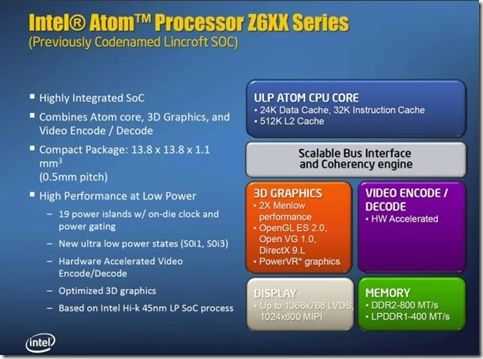Moorestown is late. There’s no way that Intel can spin it otherwise because I’ve asked officials many times and they always promised ‘products’ in 2010. All we’re hearing about is Oaktrail and the reason for that might be because there isn’t an operating system for Moorestown yet. Moblin, MeeGo and Android are all listed as supported operating systems but none of those builds are completely ready for X86 prime-time yet. It looks like Moorestown is sitting in the wings for the time being and that’s very disappointing.
While we wait, let’s remind ourselves of some of the platform characteristics.
Moorestown is a mobile-focused platform that uses an Intel Z6xx CPU where the memory bus, display controller and graphics (3D and video) are on the main die Lincroft is the codename of the CPU. There’s no BIOS, no ACPI and no real PCI bus on the controller chip (Langwell) and therefore no Windows 7 support. The platform is designed to work with a special power control chip called Brierstown which provides the ‘power island’ support which will be critical in improving battery life and, for the first time, allowing an always-on idle mode that can be used for smartphones. It also integrates tightly with the Intel wireless module called Evans Peak.
Oaktrail is similar (but includes components to allow it to support Windows) as is Tunnel Creek. Tunnel Creek (E6xx CPUs) is intended for embedded designs but contains the same graphics core as Moorestown and Oaktrail. With 2x the 3D performance of the older Menlow platform and a 20Mbps-capable hardware video decoder and 720p encoder, all based on PowerVR technology, it’s interesting to think about performance in terms of a handheld device.
Have a read at the Intel Embedded site here.












While we wait for Intel’s Moorestown – Info on GPU and HD Video Support http://www.umpcportal.com/?p=22827
While We Wait for Intel’s Moorestown – Info on GPU and HD Video Support: Moorestown is late. There’s no way that… http://bit.ly/goWLNv
While We Wait for Intel’s Moorestown – Info on GPU and HD Video Support: Moorestown is late… http://goo.gl/fb/R9tSk
The GMA 500 is so slow even with 2x the faster clocks(which won’t net 2x the performance) will be just on par with the GMA 3150 on the Netbook parts. It’s just there to run video, nothing else.
I think the problem was that Intel never bothered to optimise the GMA500 drivers since so few devices were based around the Menlow platform. Hopefully this will change with Oak Trail.
You can only go so far with drivers. We are talking 10-20% overall here(few apps will differ of course). If they suck in 3DMark which is the most optimistic scenario, it will suck more everywhere else.
I agree from a laptop perspective it will be slow.
From a mobile perspective, it will be fast though, right?
Are we expecting laptop 3D performance in our handhelds?
so, why 45nm? if they want to build mobile oriented platform, they need to use latest tech available, 32nm or maybe shoot for 20nm?
Cedar Trail (and all the various derivatives) is due in late 2011 and will be produced on the 32nm process.
The 45nm process used in Moorestown/Oak Trail are slightly different from the 45nm used in Desktop/Laptop/Netbook processors. It uses a slightly slower but significantly less leakage transistors. They call it 45nm LP for Low Power or 45nm SoC, meaning its meant for SoC devices.
Not only that, Atoms are made to be ridiculously cheap by Intel standards. Using an older process allows that to happen, because R&D costs are already paid off. Plus they have to somehow fill the capacity left by moving the chipset into the processor.
While We Wait for Intel’s Moorestown – Info on GPU and HD Video Support http://bit.ly/edjg1P
so whats the estimated 3Dmark on these? cant be any worse than the “150” by GMA3100 right?
The GMA 500 gets 70-80 in 3DMark06, so yes it can get worse than that. It’s made worse by the fact the GMA 3150 can’t run all the tests on 06, while the GMA 500 can.
@blah: If it clocks at 400MHz, which is double the clock speed, it should still outperform the SGX540 at 200MHz.
“The 535 adds a second texturing unit, and the 540 adds another two USSE pipes.”
4 USSE pipes + 2 TMUs @ 200MHz vs. 2 USSE pipes + 2 TMUs @ 400MHz
the thing is that gma500 as well as gma3100 already are lagging behind the performance really needed. that’s the problem with intel. btw all these high resolution displays on new mobile devices need graphics power as well as netbooks
Moorestown still uses the PowerVR SGX 535 core and just clocked at 400 MHz. Samsung uses the PowerVR SGX 540 core in their SoC which is better than the SGX 535 per MHz. So Moorestown based smart phones will be on par or slower than other smart phones that use the PowerVR or Adreno cores.